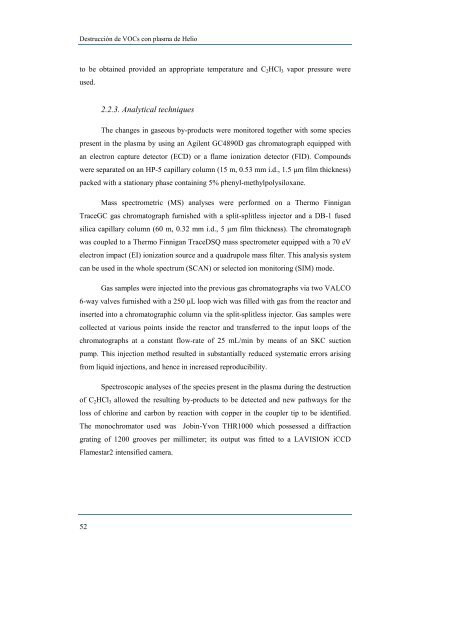estudio y caracterización de un plasma de microondas a presión ...
estudio y caracterización de un plasma de microondas a presión ...
estudio y caracterización de un plasma de microondas a presión ...
Create successful ePaper yourself
Turn your PDF publications into a flip-book with our unique Google optimized e-Paper software.
Destrucción <strong>de</strong> VOCs con <strong>plasma</strong> <strong>de</strong> Helio<br />
to be obtained provi<strong>de</strong>d an appropriate temperature and C2HCl3 vapor pressure were<br />
used.<br />
52<br />
2.2.3. Analytical techniques<br />
The changes in gaseous by-products were monitored together with some species<br />
present in the <strong>plasma</strong> by using an Agilent GC4890D gas chromatograph equipped with<br />
an electron capture <strong>de</strong>tector (ECD) or a flame ionization <strong>de</strong>tector (FID). Compo<strong>un</strong>ds<br />
were separated on an HP-5 capillary column (15 m, 0.53 mm i.d., 1.5 µm film thickness)<br />
packed with a stationary phase containing 5% phenyl-methylpolysiloxane.<br />
Mass spectrometric (MS) analyses were performed on a Thermo Finnigan<br />
TraceGC gas chromatograph furnished with a split-splitless injector and a DB-1 fused<br />
silica capillary column (60 m, 0.32 mm i.d., 5 µm film thickness). The chromatograph<br />
was coupled to a Thermo Finnigan TraceDSQ mass spectrometer equipped with a 70 eV<br />
electron impact (EI) ionization source and a quadrupole mass filter. This analysis system<br />
can be used in the whole spectrum (SCAN) or selected ion monitoring (SIM) mo<strong>de</strong>.<br />
Gas samples were injected into the previous gas chromatographs via two VALCO<br />
6-way valves furnished with a 250 µL loop wich was filled with gas from the reactor and<br />
inserted into a chromatographic column via the split-splitless injector. Gas samples were<br />
collected at various points insi<strong>de</strong> the reactor and transferred to the input loops of the<br />
chromatographs at a constant flow-rate of 25 mL/min by means of an SKC suction<br />
pump. This injection method resulted in substantially reduced systematic errors arising<br />
from liquid injections, and hence in increased reproducibility.<br />
Spectroscopic analyses of the species present in the <strong>plasma</strong> during the <strong>de</strong>struction<br />
of C2HCl3 allowed the resulting by-products to be <strong>de</strong>tected and new pathways for the<br />
loss of chlorine and carbon by reaction with copper in the coupler tip to be i<strong>de</strong>ntified.<br />
The monochromator used was Jobin-Yvon THR1000 which possessed a diffraction<br />
grating of 1200 grooves per millimeter; its output was fitted to a LAVISION iCCD<br />
Flamestar2 intensified camera.

















